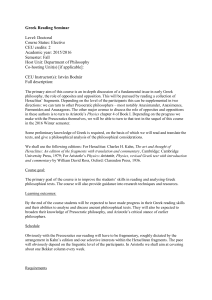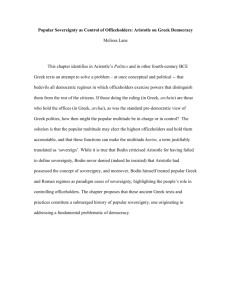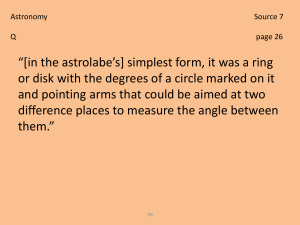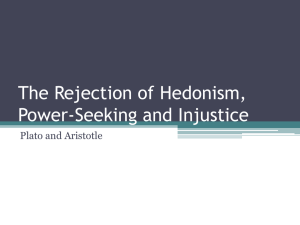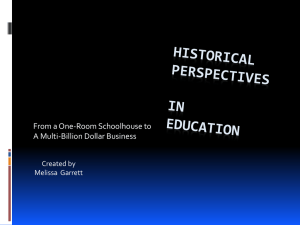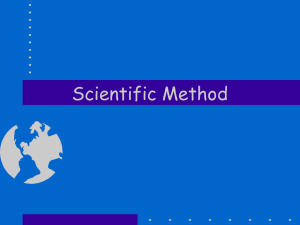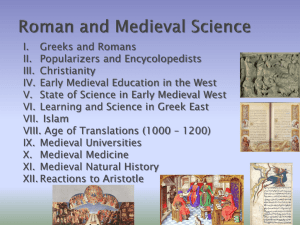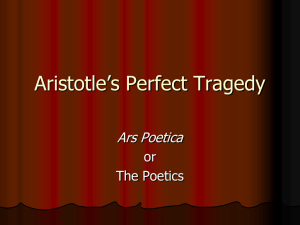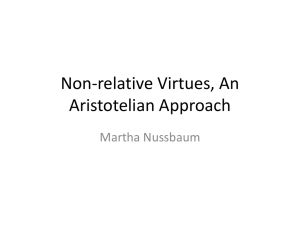Slides, ppt
advertisement
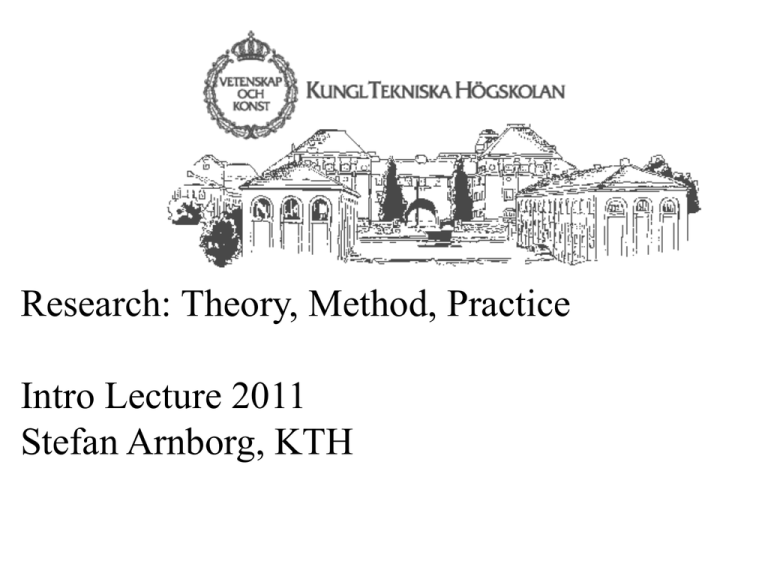
Research: Theory, Method, Practice
Intro Lecture 2011
Stefan Arnborg, KTH
Courses FD3001: 7.5hp
DA2205: 3hp of 7.5
Examination: Presence on lectures with external lecturer
Homework: 2 papers:
DA2205: 2 from list
FDD3001: 2 from list, except 1 and 2
1: Self-presentation
2: Press Release
3: Grant Application
4: Paper Analysis
5: Fraud Investigation
6: Proposal Review
7: Media Event
8: Self presentation and press release
9: Elective (must be approved by me)
Course Goals
You should be able to discuss and analyze the different value
judgments that research communities recognize, in a broad area
of research covering at least the CSC school of KTH, be able to
evaluate research questions in these areas and relate them to
principles and theories proposed in the philosophy of science
and technology.
You should be able to find relevant and valid information on ethical
principles guiding your conduct as researcher, and be able to
apply it in your daily life as researcher.
You should be able to present your research and to plan
presentations for different purposes. In these you should be
able to find and communicate suitable motivations why your
work leads to a better society - sustainable, bearable, robust,
exciting, etc.
Course Goals
You should find it natural to present yourself, to an appropriate
level of detail, as a researcher in different social contexts.
You should be able to find relevant information and procedures for
financing research, fundamental and applied, and present
rhetorically appropriate research plans for different financing
agencies, written as well as oral and social.
Course Evaluation 2008-2010
-- Few answers to computerized survey. Please answer after
course ends.
-- External lecturers very good, but more women and something
on gender research requested.
-- Both course books good (but choose carefully)
-- One student found advicing ‘insufficient’: Let me clarify
that YOU ask for advice, I am not hunting for students to
advice. If you have not received answer to a mail within four
days, please ask again.
-- Feedback is given within a week during course (until
homework deadline). After that, I must put priority on other
things, so answers will be shorter and delays longer.
Norms of Academic Science:
Merton 1942
• C communism (or communitarianism)
• U universality: universal knowledge
• D disinterestedness: no personal stakes(except
honour)
• O originality: NEW knowledge
• S scepticism: try to falsify
• Merton’s context: relation between power and scientist in
dictatorships (Hitler, Stalin). Border between society and
science demarcated.
Schleiermacher
Odogmatisk religion
WvH:s tankesmedja
Christoph Markschies:
Was von Humboldt
noch zu lernen ist,
Berlin UP 2010
The idea of a University
“A University is a place … whither students come from
every quarter for every kind of knowledge; … a place
for the communication and circulation of thought, by
means of personal intercourse. … It is the place to
which a thousand schools make contributions; in
which the intellect may safely range and speculate. It
is a place where inquiry is pushed forward, … discoveries
verified and perfected, and … error exposed, by
the collision of mind with mind, and knowledge with
knowledge. … Mutual education, in a large sense of
the word, is one of the great and incessant occupations
of human society. … One generation forms another.
… We must consult the living man and listen to his
living voice, … by familiar intercourse … to adjust
together the claims and relations of their respective
subjects of investigation. Thus is created a pure and
clear atmosphere of thought, which the student also
breathes.” So wrote John Henry Newman in The Idea
of a University in 1852.1
Post-Academic Science:
Ziman 2000
•
•
•
•
•
P proprietarian ( IP, business opportunity)
L local: related to local network of stakeholders
A authoritarian: hierarchical control
C commissioned (researcher is ’consultant’)
E expert: role is problem-solver
• Ziman’s context: Universities are like any
corporations, and output directly economically
measurable. Globalization
• Etzkowitz: Triple Helix: Academy/Region/Industry
Lyotard
• The post-modern condition:
Commissioned work for Montreal
Education authority - prophetic
• Fight against concept of ’Grand
Narrative’ as opposed to complex web
of ’micro-narratives’
Commodification of Knowledge
• Knowledge is a commodity like all
that counts: It is produced, sold,
bought and consumed in a setting
where market, production
efficiency, price and marketing is
more relevant than whatever
Humboldt and his peers thought
about.
(≈ Lyotard, 1984)
• Valuable is knowledge that can
be cogged into production and
advising systems of society.
• Less valuable is knowledge that
questions the current political
thoughts about society’s
development.
Lyotard: La condition post-moderne
-rapport sur le savoir
Soyez opératoires, c’est-à-dire commensurables, ou disparaissez.
Is Praxiteles’ work already in the
marble?
NO: Structure of Science (and Truth) is
the outcome of a practice
Which claims can be resisted?
Which can be made?
Which allies can be brought in?
Which links resist?
Scientific truth defined
in centers of calculation
and verified in galleries of
a community of practice
extending through society
as an actor network
Callon, Latour ca 1985
What is Truth?
• Plato: Rationalistic, Cave simile, observations unreliable. Cf Meno.
• Aristotle: Deductive truth: What follows from true assumptions is true. Whats
opposite can be deductively refuted is true. (cf proof by contradiction,
statistical hypothesis tests) Aristotle: Inductive truth: What regularly obtains
is true (cf statistical inference)
• Peirce: What a community of scholars eventually agrees upon is Truth.
• Latour: Something is True if it cannot be resisted, tied into a network of
irresistible microsociological relations between humans, ideas and material
artefacts.(ANT)
Progress of Science
• Accumulation of observations, experiments and
theories (Francis Bacon, Auguste Comte).
Naive positivism.
• Theories are prior to observations, the latter Confirm
(Carnap) or Falsify (Popper) theories.
Logical Positivism
• Scientific progress is revolutionary (Kuhn,
Feyerabend). Paradigms, or ANYTHING GOES.
• Latour, Callon: science is a ’social’ activity connecting
the research activity with an’actor network’ linking
humans and artefacts into a robust network ensuring
financing, carreers and recruitment.
Kuhn: Paradigms in Science
• Normal Science: Exemplar to take after,
filling in gaps, ’goldplating’
• Anomalies: Try to explain anomalies by
interpretation of experiments and
observations. No rejection of theory
• Crisis: Anomalies are serious enough to
reject theory and force a new PARADIGM.
• Typically, a new paradigm is not universally
but only gradually accepted.
Feyerabend - Against Method
Science is an essentially
anarchistic enterprise
The only principle that does
not inhibit progress is:
ANYTHING GOES
Hypotheses contradicting
well-confirmed theories give
us evidence that cannot be
obtained in other ways
If there is a driving force in
science, it is aesthetics.
Hawthorne and Placebo
• Clients of Healers & Homeopathists, subjects in the
‘no-intervention’ group
can also see positive changes
• Is this pseudoscience?
(Kathy Sykes’ TV programmes)
• Brain’s reward system releases
signal substances that have the
same type of effect as drugs?
• Similarity with managerial methods:
reorganisation, reform, events,
kickoffs, and other rituals
• Current fight between therapists
(CBT) and psychiatrists (drugs).
This book argues that
conceptual metaphor
plays a central,
defining role in
mathematical
ideas within the
cognitive unconsciousfrom arithmetic and
algebra to sets and
logic to infinity in all of
its forms: transfinite
numbers, points at
infinity, infinitesimals,
and so on.
Goals in Research, sketch:
•
•
•
•
Humanities: Understanding Phenomena
Social Sciences: Improve society
Natural Science: Predict outcome of experiments
Mathematics:
1:Solve problems - prove theorems (Erdös)
2:Create Landscape in which theorems can be
defined and proved (Thom).
• Engineering Science: What other sciences forgot,
enabling new technology deployment.
Qualitative Research
• Margaret Mead: Best known
(to American public) scientist
before Einstein
• Coming of Age in Samoa,
≈1925 - controversies settled
or not?
• Immersion, constructing
Three Inconvenient Germans
• Karl Marx (1818-1883) Class,
Organization of Production, Revolution
Founder of latest state religions
• Friedrich Nietzsche (1844-1900).
Aesthetics revolutionized, existentialist
and post-modernity icon
• Sigmund Freud (1856-1938), discoverer
of the unconscious
Max Weber on Marx and Nietzsche
1920: Anyone in the Social Sciences
or the Humanities who claims his
work independent of Nietzsche and
Marx is either dishonest or
incompetent
Why look at Greek science??
• Well studied and documented
• Greek classicism shapes our way of seeing
the world.
• Greek society cruel: Slaves, Wars,
Racism,Oppression of women
(i.e., like Europe)
• Greek science builds on significant
knowledge in China, India, Persia - most
written accounts from there are however lost
Beckwith: Empires on the Silk Road
Thales -585
Anaximander 611-547
Anaximenes -502
Pythagoras 570-508
Parmenides 510Zenon 488Empedokles 450
Herakleitos 540-480
Anaxagoras 500-428
Protagoras 420
Demokritos 460-370
Sokrates 469-399, Antisthenes
Platon 428-348
Aristarkos
Aristoteles 384-322
Herodotos 425
Arkimedes -300 E
Euklides
Appolonius
Epikureos 342-270
Selevkos
Epiktetus 50-125
Hipparkos
Poseidonius 100
Theory of Evolution
• First account by Anaximandros,
including sketch of natural selection
• Based on mechanistic view, not
Intelligent Design
• Restated by Empedocles
• Rejected by Aristotle as implausible.
Teleological explanation. Important
paradigm shift.
Modern theory of Evolution
• Based on careful collection of supporting observations
(many of which can also be found in Aristotle: Parts of
animals)
• Was apparently refutable by age of earth (Kelvin could
not know about heating of earth by radioactivity ) and
lack of understanding of genetics (Mendel’s work had
been unnoticed, despite said to have been lying on
Darwin’s desk)
• Still considered somewhat daring, but only remaining
’serious’ hypothesis.
Greek Astronomy
•
•
•
•
Relied on Eastern knowledge (Persia, India,…)
Predict eclipses (Thales, 585 BC)
Sizes of earth, moon, the zodiac to within 1%
Size of sun : Aristarkos: sun’s diameter 180 times that
of earth ->
Heliocentrism is a plausible model
• Poseidonius (teacher of Cicero):
Diameter of sun 9893 times that of earth (50% low,
best result in antiquity!) Poseidonius also explained
tidal water (sun, moon) - made possible tidal water
tables
Astronomy
• Aristotle, Hipparkus and Ptolemai were geocentrists
• Appolonius: Defined both conic sections (used by Kepler) and
the epicycle system (used by Ptolemai).
… and in the west?
• Copernicus: Sun might be the center because of its majestic
appearance? (similar to Aristarkos quantified argument)
• However, predictions based on heliocentrism were inferior
for a long time
• It took more than 100 years before Kepler saved the
heliocentric view by using Appolonius’ conic sections instead of
his epicycles. Difference is in the kinematics.
• If the heliocentricists had followed a scientific method, they
should have rejected their hypothesis(Feyerabend).
Aristarchus On the Sizes and
Distances of Sun and Moon
Tycho Brahe’s system
• The moon and sun
circle around earth, but
planets around the sun
• Absence of stellar
parallax indicates
geocentrism
• Also convenient
and safe wrt church,
• Which made Brahe a
looser, undeservedly
because his system is
’almost right’.
Tycho Brahe: First ’Big Science’
•
•
•
•
•
The construction of Uranienborg consumed a
sizeable proportion of Danish State Income.
Tycho Brahe was the first (documented) ’Big
Science’ performer
He had to motivate his needs by writing
horoscopes for kings and their like
Today’s big scientists also have to motivate their
needs by guessing about the practical use of their
expensive equipment
Physicists typically succeed in motivating new
CERN equipment by referring to employment
opportubnities and uncertain spin-offs - this does
seldom work in other areas.
Atomism
• Not unique for Greek philosophers
• Democrit, Leukippos suggested atomism,
from observations of life cycles and chemical
processes
• Epikuros combined it with an ethics of ‘no
after-life’, explicated in one of the great
antique works of literature, Lucretius ‘ De
Rerum Natura’, On the Order of Nature.
The ‘Dark ages’
• Greek science and literature survived in the Byzantine and
Muslim worlds, although not in a central position
• Applied to rational analysis of theological problems (Ibn Rushd),
medicine (Ibn Sina), social science (Ibn Khaldun).
• Grinding halt after destruction of Baghdad (1258) and conquest
of Constantinople (1453)
• Translated to Latin from Greek and Arabic (Plato, Aristotle)
• Aristotle surpasses Plato as ‘the Philosopher’,
treated as semi-god rather than human.
• Scholasticism - fascinating, but not in line with course
Islamic Science
• The first islamic law schools (ca 800), e.g., in Fez,
developed the academic degree system and CV
concept (Doctor’s degree, promotion and hat) which
were taken over by European Universities
• Jocius of London founded ‘Collège des dix-huit’ on
model of ‘madrasa’ and ‘vihâra’
• Mufti -> professor of opinion (fatwa), mostly in law,
• Faqih -> Master, licenced to practice profession
• Muddaris -> Doctor, licensed to teach
Islamic Scholars
• Ibn Sina (Avicenna), ca 1000, practice
based medicine (antibiotics, vaccines
(inoculation)).
• Ibn Rushd (Averroes), ca 1200,
precursor of scholasticism, mixing
‘axioms’ in the form of Quran
statements with observations, deriving
new truth by syllogism. Saved Aristotle,
clash with fundamentalism.
Ibn Khaldun (ca 1360):
Muqqadimah
• Politician, social scientist, historian, economist.
• First statements of market theory, importance of
stable institutions, property right, stable currency
• First scientific Marxist (without political program):
Power and wealth distribution depends on how
production is organized
• ‘Anyone can have ideas, but only through words and
language can you convince’
Newton,
(1642-1727)
1665 - Alchemy
1666 - Calculus
1667 - Fellow, Trinity College
1669 - professor
1682-4 Principia
1689 - Parlamentarian
1692 - Opticks
1696 - Royal Mint
1703 - Royal Society
1733 - Daniel and Apocalypse
First modern or last ancient??
Standard view on Math Phil
•
•
•
•
•
•
•
•
•
Mathematical results are certain
Mathematics is objective
Proofs are essential
Diagrams are unnecessary
Mathematics is safely founded in logic
Independent of senses
Cumulative, setbacks trivial
Computer proofs are kosher
Some exotic problems in math are unsolvable
What is a good Math
result?(Bauer)
• Somewhat difficult to find
• Fits into an existing paradigm (there are
several), ’significant result’.
• Correct if agreed to be correct by reviewers
• Most results are forgotten - if there are errors,
no-one finds them
• Most accepted results continue to be correct.
• However, acceptance is not proof of
correctness
Exemplar paradigms in math
• Socrates in Plato’s Meno - arguments less
formalized than ‘modern’ proofs. Similar methods
applied, e.g., by Pythagoreans
• Aristotle/Euclid: Rigor stepped up, exemplary until
1960:s
• Newton, Leibniz, Maxwell, Euler, Stokes:
new math rather confused, carried by community of
practitioners (Wranglers)
• Critizised by Bishop Berkeley: The Analyst.
• Bolzano, Weierstrass, Cauchy, Dedekind:
Foundations of ‘rigorous analysis’.
Analysis ‘King’ of Math.
Cambridge Wranglers
-Created the math you studied:
Green, Stokes, Macauly, Routh
Maxwell, Larmor,
Cunningham, Dirac…
-Competitive math
examination aimed at ranking
candidates for fellowships --Appointments for life with no
particular duties -- often
awarded at age 20-25
Foundational Crises
• Hilbert last polymath: 23 centennium problems in
1900. Hilbert’s program.
• Russell, Whitehead: Realize logical foundation:
develop all of math within logic.
• Surprise: Math and computation undecidable (Gödel,
Turing). Several of Hilbert’s problems not solvable.
• Constructivism/Intuitionism: Only what can be
‘intuited’ can be real. Scientific Computation
• Computational Complexity (& Algorithms)
• Math ‘educational’ crisis: interest waning, culture
disappears (Matematikdelegationen).
Zermelo-Fraenkel Set Theory
with Axiom of Choice (ZFC)
• Extensionality: Two sets are the same if they have the same
members.
• Empty set: There is set with no element.
• Pairing: for sets x and y there is a set containing x and y,
and nothing else.
• Union: for any set F there is a set containing every member
of every member of F
• Infinity: There is an infinite set, eg {{},{{},{{}}},…}
• Axiom (schema) of specification: For every set x and
property P, there is a set consisting of those members of x
satisfying P.
• Replacement:
Zermelo-Fraenkel Set Theory
with Axiom of Choice (cont)
• Axiom of separation (definition): For every set x and property P, there is
a set consisting of those members of x satisfying P (and only those).
• Replacement: For a function f and subset of its range x, there is a set
containing the image of x,
{y:y=f(z) | z x}
• Power set: For set x, there is a set consisting of the subsets of x
• Regularity: Every non-empty set x contains an element y disjoint from it.
• Axiom of Choice: Given a set x of mutually disjoint non-empty sets, there
is a set containing exactly one element from each member of x
Zermelo-Fraenkel Set Theory
• The safest and most accepted logical foundation of
mathematics
• Consistency of ZFC cannot be proven within ZFC
• Consistency can be shown with forcing (Paul
Cohen), as well as the independence of the
Continuum Hypothesis (Hilbert’s first problem) and
other somewhat subtle things
Intuitionism/constructivism is
computational
• Building on the positive integers, weaving a web of
ever more sets and more functions, we get the basis
structures of mathematics. Everything attaches itself
to number, and every mathematical statement
ultimately expresses the fact that if we perform
certain computations within the set of integers, we
shall get certain results. Even the most abstract
mathematical statement has a computational basis.
(Bishop & Bridges, 1985)
This book argues that
conceptual metaphor
plays a central,
defining role in
mathematical
ideas within the
cognitive unconsciousfrom arithmetic and
algebra to sets and
logic to infinity in all of
its forms: transfinite
numbers, points at
infinity, infinitesimals,
and so on.
Alan Turing: Halting Theorem
First result in computational
complexity:
It is not possible for a computer
to decide whether or not a
computer computation
(with unbounded memory)
will terminate.
Proof by reduction: If such a
method (computer program)
exists, a program can
be constructed which must
terminate and also must not
terminate
The Art of Computer Programming
D.E. Knuth.
Started 1962.
Vol 1: Fundamental Algorithms, 1968
Vol 2: Seminumerical Algorithms, 1970
Vol 3: Searching and Sorting, 1973
TeX, ….
Vol 4: Combinatorial Algorithms,
Vol 5: Syntactical Algorithms
Vol 6: Theory of Languages
Vol 7: Compilers
Algorithms
• Measure performance asymptotically
• Multiplication Example:
as in school:
• Smarter: Fourier transform,
Multiplication lower bound:
, since you must
look at every input bit.
• There is typically a (very) significant gap between
lower and upper asymptotic bounds: even the lowest
cost of multiplication is not known.
The Turing Machine
Opening a combination
lock is difficult
Unless you know its combination,
10 61 78 20 12,
you must try a billion combinations
Winners of Cipher Challenge
2001
RSA cryptosystem uses that primality is easy, but factorization
is difficult (Rivest, Shamir, Amir, 1971)
Produce two large
primes and multiply
them. Produce a
pair of keys (E,D).
With the product and
E (public key) you
can encrypt messages
but you can only
decrypt if you have
D and the product,
or know E and the
factors
RSA secrets are temporary!
Year
Largest prime
Biggest factorization
Long ago
1957
1982
2005
10 digits
1000 digits
13400 digits
8.7 million digits
77
155 digits
One day your key will be factorizable!
Or, this day may be tomorrow
Or yesterday for a paranoic cryptographer
With time, the chart of
complexity classes has
become embarrassingly
complex. And it rests on
unproved conjectures.
Logics of knowledge and belief
Games
Combinatorial optimization
Feasible problems
Parallelizable problems
2006: 442 classes in the
complexity zoo
Zero-knowledge proofs
• Graph 3-colorability :
• Given graph (V,E), known by both
p(rover) and v(erifier). Only p has
access to a 3-coloring : V{1,2,3}
• In each round:
p permutes colors, randomization π
sends each π(i) in sealed envelope to v.
v asks for two specific adjacent vertices i,j, and
p unlocks them. Now v can verify (i)≠ (j).
• v has probability ≥1/|E| to reveal a bluff in each round
- if there is one
Zero-knowledge
Fundamental tool for cryptographic
protocol analysis:
•Key exchange and verification
•Digital Cash: Anonymity, check against
multiple spending …
•Voting: No cheating, anonymity, no selling
of votes …
=?
0100100010100010001111110
